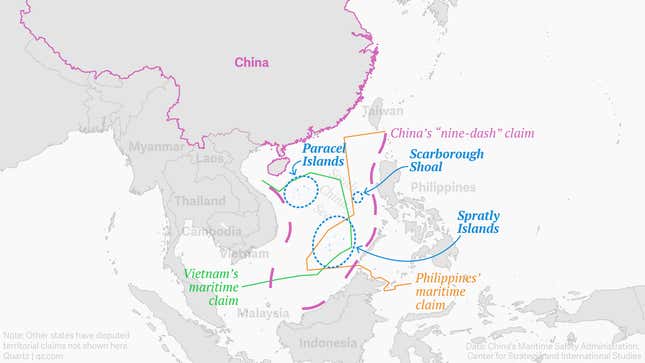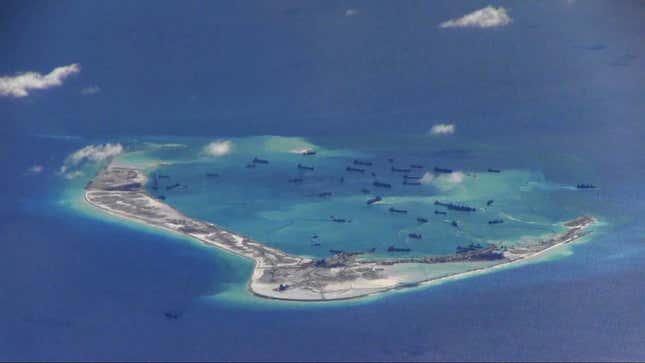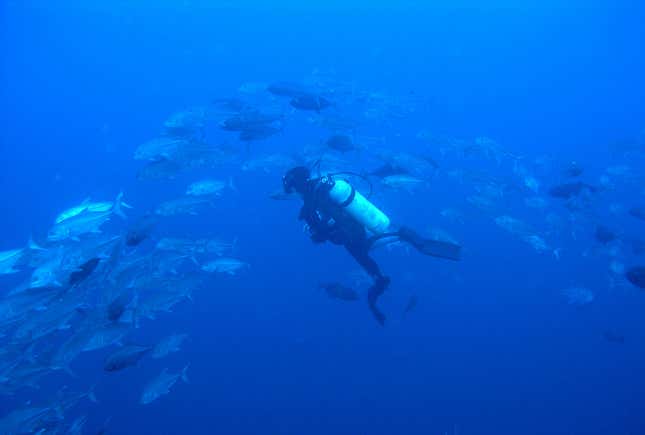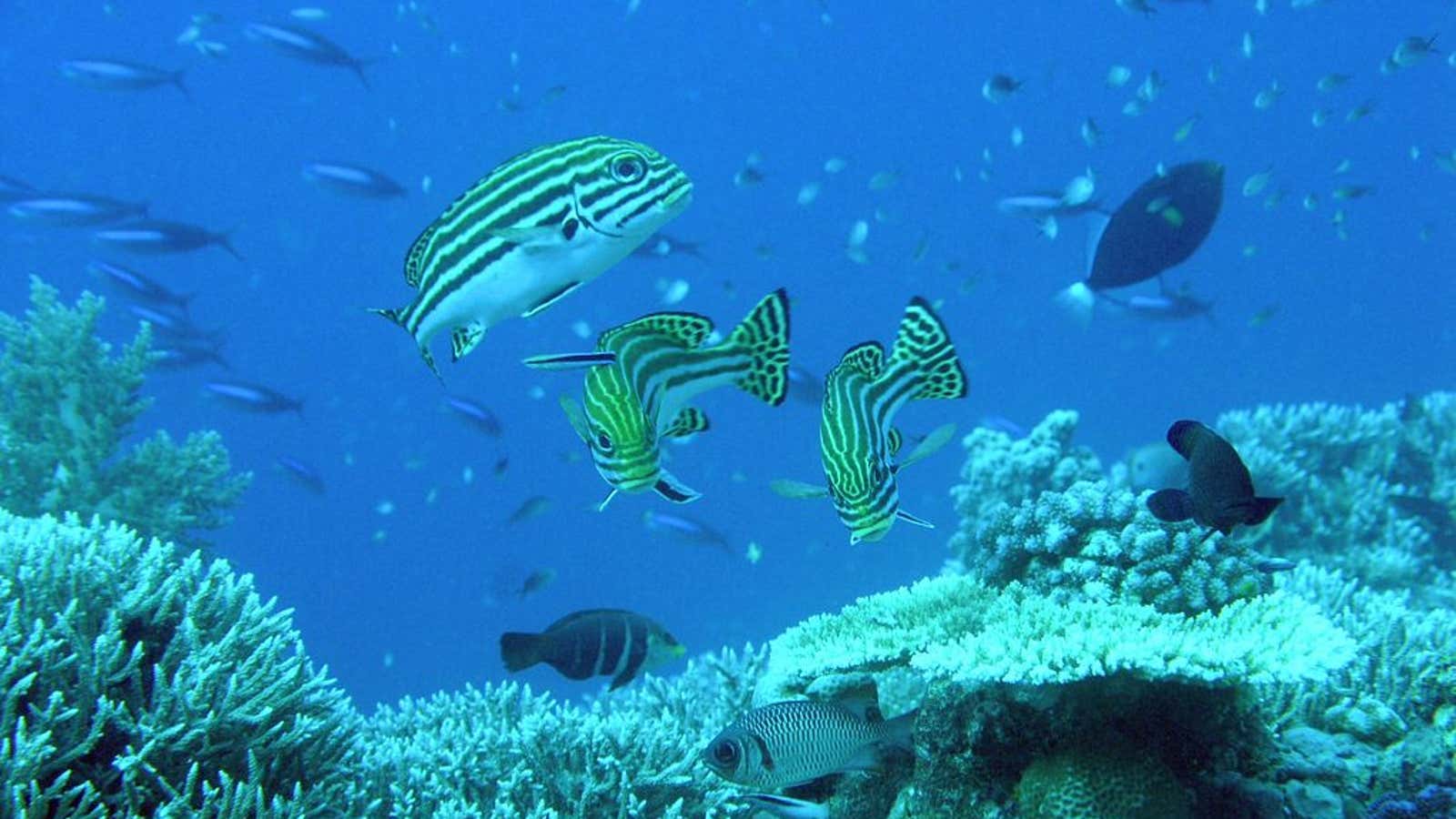For all the militarization and territorial squabbling in the South China Sea, there is at least one good reason for the nations involved to work together: fish larvae.

One of the sea’s main areas of contention is the Spratly archipelago, an area the size of Tunisia featuring emerged rocks, tiny islands, and hundreds of coral reefs that various nations claim as their own. (China claims the entire archipelago, and nearly the entire sea and everything in it, as its own.) Back in the early ’90s, marine biologist John McManus proposed turning the area into an international marine reserve (pdf, pages 2 and 5), with “a truce to ownership aspirations for a definite period, such as 50 years, with an option for review and indefinite renewal.”

This, he argued, would benefit a wide range range of nations. He noted the archipelago serves as an important breeding ground for marine life, and that currents move in such a way as to distribute larval fish to the coastal areas of a region that otherwise suffers from severe overfishing. The Spratlys, he wrote (pdf, p. 3), “could be considered a ‘savings bank’ where commercially important fish and invertebrates (as capital) are saved from overharvest (albeit unintentionally for now), and supply a constant flow of larvae (as interest) to areas of depletion.”
Antonio Carpio, the senior associate justice on the Supreme Court of the Philippines, revived the idea on Friday (July 15).
It would mean a halt to the destructive practice of building artificial islands in the Spratlys as a way to bolster territorial claims. In the past few years China has been constructing such islands at a furious pace, adding everything from runways to barracks to a farm boasting hundreds of livestock. (Other nations have also engaged in some reclamation and island-building in the area, but their efforts have been dwarfed by China’s.)

On July 12 an international tribunal ruling invalidated Beijing’s “nine-dash line,” which China uses to justify its sweeping claim to most of the sea. That sparked angry reactions in China, where patriotic fervor is running high over the issue. China conducted military drills in the sea before and after the ruling, and vowed this week (July 18) to continue building in the Spratlys.
Carpio suggested a marine park would allow China to save face and be a “win-win” solution for it and other nations. Infrastructure already built in the Spratlys could become marine research and eco-tourism facilities, he said.

“By turning the Spratlys into a neutral, international marine park, all claimants could continue to benefit from the living resources emanating from the area, and a host of potential conflicts could be avoided,” McManus noted in 1992 (pdf, p. 4).
He suggested the park would have an international management board, tourism facilities, research facilities and programs, a private surveillance force, and a contracted research and management institution.
Of course, that would only cover the Spratlys, and the sea holds other points of contention, including ones involving untapped oil and gas reserves. But it would be a start, and similar concepts have worked elsewhere. The Antarctic Treaty included a moratorium on resource claims when it was enacted in 1961, for example, and has since helped prevent conflict and environmental damage in the region.
Certainly the Spratlys has enough underwater beauty to make it work as a marine park. Claimed by Malaysia, the archipelago’s Swallow Reef (also called Layang Layang) features a resort that has been attracting scuba divers for years. It’s a highly rated diving destination.
“These are some of the most beautiful reefs I’ve ever seen with some of the highest levels of biodiversity in the world,” McManus told the Guardian last year.
Today McManus, a professor at the University of Miami in Florida, continues to stand by the idea. In an email to Quartz, he writes:
The key elements for any treaty to protect the environment and prevent an impending multispecies fishery collapse across the South China Sea would be a freeze on claims (keep them as they are), a freeze on claim supportive activities (nothing a country does during the treaty period can be used in the future to define its claims), and a joint management, including coordinated fisheries regulations and standardized environmental protection. Taken together with recent additional environmental and fishery agreements, the Antarctic Treaty System is a good starting point for developing the necessary treaty. A particular emphasis on the Spratly Islands and Scarborough Reef, a Greater Spratly Islands Peace Park, would enhance tourism and protect sources of larvae of important fish and invertebrates which are needed to prevent local extinctions of constantly over-harvested species along coastlines around the South China Sea. The Park Management system would be able to handle such things as conducting search and rescue operations, in addition to environmental protection and enforcing fishery regulations. They could be based at the various military bases already in place.
Amid all the current tension in the South China Sea, turning the Spratlys into a marine park might sound like a fantasy. But the very fact that the idea continues to resurface so long after it was proposed speaks to its staying power—and suggests there’s something to it.

Underwater images by Matthew Lee on Flickr, licensed under CC-BY-2.0.
